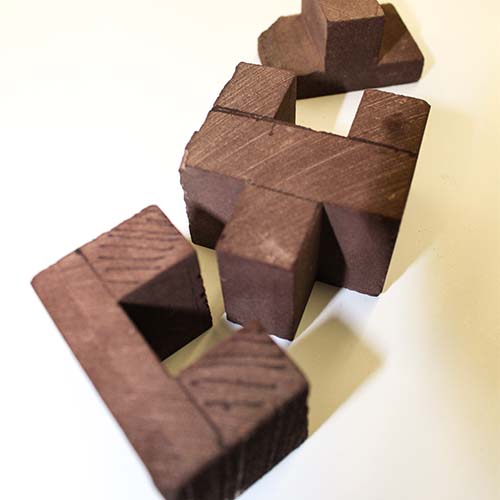Applied Research


ADDITIVE MANUFACTURING
Basalt Research for Space Resource Utilization
Humans will soon return to the Moon for the first time in more than 50 years—and this time to stay. NASA’s Artemis program and commercial partnerships are gearing up to establish a permanent human presence on the lunar surface. Creating infrastructure for life support, transportation, and resource management will be essential in supporting a long-term lunar mission. Since launching materials from Earth is too costly and impractical, we must rely on the Moon’s resources. The key to sustainable lunar living lies in using what’s already there to build the foundations for future exploration.
At PISCES, our research focuses on developing novel ways to turn lunar resources into useful materials—a process known as in-situ resource utilization (ISRU). For more than a decade, we’ve been studying ISRU techniques using Hawaiʻi basalt as a lunar simulant. Through years of sampling, analysis, and testing, we have identified the ideal basalt compositions for creating highly durable materials that could one day be used for launch pads, roads, shelters, and other infrastructure on the Moon. With few to no additives or toxins used in the process, our basalt products also have practical uses on Earth.
REGOLITH SIMULANT
Why Hawaiʻi Basalt?

Graph: Chemical profiles of 8 different basalt samples from Hawaiʻi Island are compared with a Martian meteorite.
When Hawaiʻi comes to mind, you probably donʻt think about the Moon or Mars. But the barren volcanic landscapes found on Hawaiʻi Island actually have a lot in common with our neighboring celestial bodies. Not only do they look similar, but they have a similar chemical makeup. Our research confirms that Hawaiʻi’s basalt is comparable to lunar and Martian regolith (dirt and dust), making it an ideal simulant for studying how to build sustainable infrastructure beyond Earth. By refining these methods, we move closer to enabling long-term space missions that rely on the resources already available in extraterrestrial environments.
PREVIOUS WORK
Successful ISRU Projects
Low-Energy Additive Manufacturing
In 2021, we partnered wtih Masten Space Systems on a NASA Phase 1 STTR grant to research a low-energy additive manufacturing technique that could create materials for shelters, roads, and landing pads on the Moon and Mars. Formulating a novel binder-regolith composite, we created bricks that cured with a relatively low level of thermal energy, improving energy efficiency using only raw materials that can be found in-situ on the Moon and Mars.
The second phase of the project has been funded through a NASA Phase 2 STTR grant and is developing an extruder for the binder-regolith composite that can withstand harsh environments while automating the manufacturing process.


Planetary LEGO Blocks
In 2017, we received a NASA Small Technology Transfer Research (STTR) Phase 1 grant in partnership with Honeybee Robotics to develop Planetary LEGOs—an interlocking brick made with sintered Hawaiian basalt for additive manufacturing applications. This project created a refined block design and an automated construction process to fit the blocks together. Our technicians discovered the ideal sintering temperature and duration to mold basalt fines into large, durable bricks.
Enlisting help from the creative minds of our interns, the LEGO design was reimagined for greater versatility, including vertical and horizontal construction applications. Our friends at Honeybee Robotics designed the robotic mechanisms needed to automate the entire process—from sintering and molding the blocks, to building structures with them.
Robotically Built Launch & Landing Pad
In late 2015, we completed a robotically built launch and landing pad using only sintered basalt in collaboration with NASA SwampWorks, Honeybee Robotics, ARGO, and the Hawaiʻi County Department of Research and Development. This unique project paired in-situ resource utilization with the capabilities of our Helelani planetary rover. Helelani was equipped with a leveling blade and robotic arm to grade the launch pad site and place sintered basalt pavers. NASA SwampWorks remotely controlled the rover from Kennedy Space Center in Florida, laying 100 pavers that comprised the landing pad surface. In addition to developing ISRU technology, the project served as a practice exercise for NASA’s Resource Prospector mission to the lunar surface.


Lunar Concrete
In Spring 2015, we partnered with the Hawaiʻi County Department of Research and Development, the University of Hawaiʻi at Mānoa, NASA, and Kodiak FRP Rebar to pour a “lunar sidewalk” in downtown Hilo. The sidewalk consisted of several different experimental concrete slabs made of sintered basalt. Our goal was to test and develop a sustainable construction material that could be used on Earth and other planets. Three sections were installed including a fly-ash basalt paver, a baked basalt paver, and a fly-ash binder reinforced with Kodiak FRP basalt rebar.
After a one-year assessment, our test results found the fly-ash basalt paver exceeded the durability of traditional concrete. The baked basalt pavers showed less durability, but were redesigned for our robotically built launch pad project where they outperformed residential concrete.
Through this project, we aimed to reduce the environmental impacts and expense of importing more than 300,000 metric tons of cement to Hawaiʻi each year. Globally, cement production accounts for an estimated 5 — 7% of total CO2 emissions.